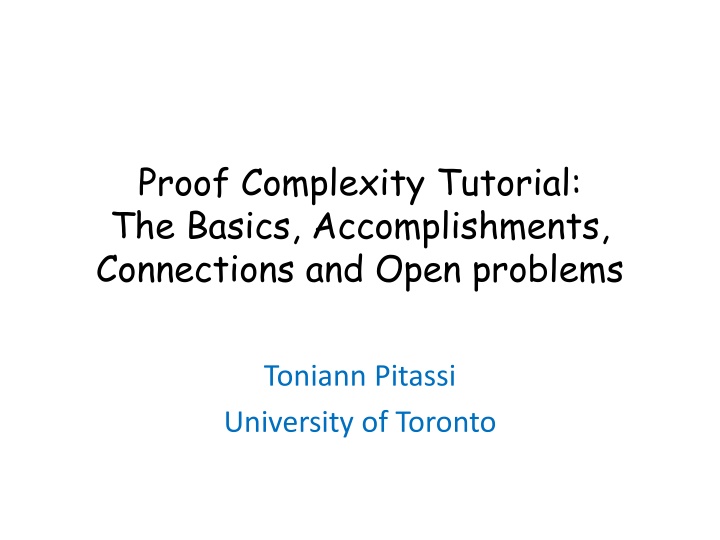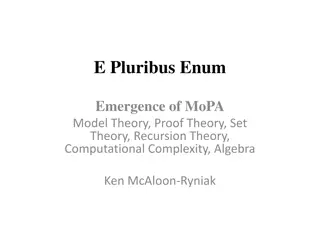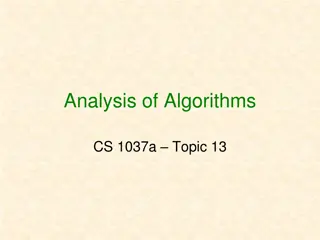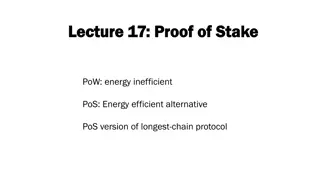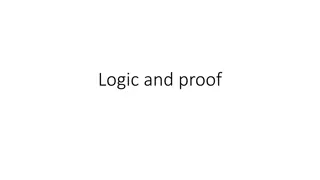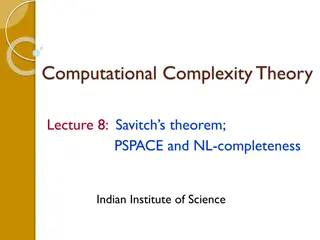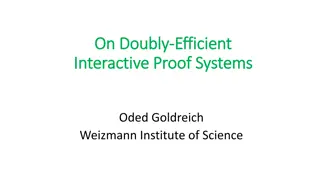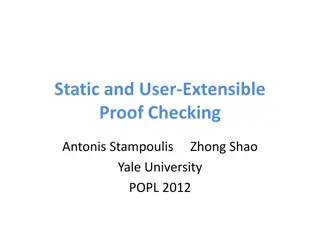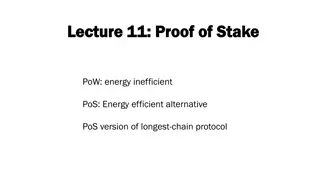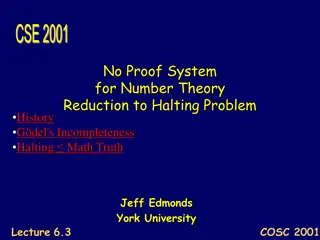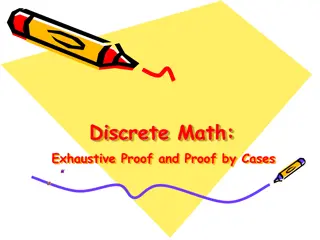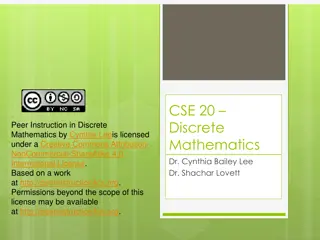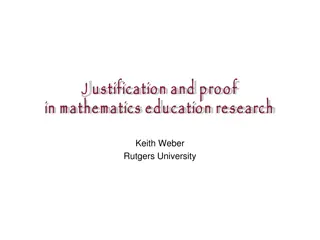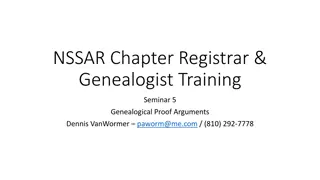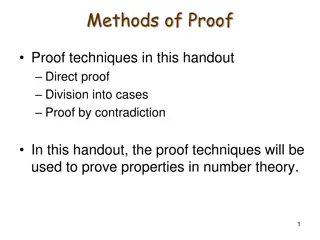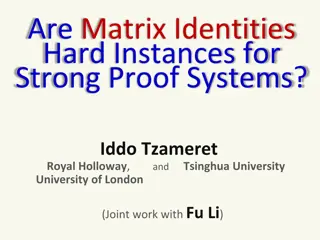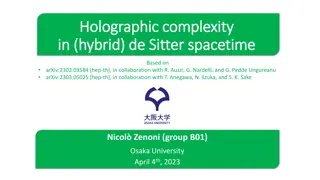Proof Complexity: The Basics, Achievements, and Challenges
Delve into the intricacies of proof complexity, covering propositional, algebraic, and semi-algebraic proof systems, lower bound methods, and algorithmic implications. Discover fundamental connections to complexity theory and open problems in the field.
Download Presentation

Please find below an Image/Link to download the presentation.
The content on the website is provided AS IS for your information and personal use only. It may not be sold, licensed, or shared on other websites without obtaining consent from the author.If you encounter any issues during the download, it is possible that the publisher has removed the file from their server.
You are allowed to download the files provided on this website for personal or commercial use, subject to the condition that they are used lawfully. All files are the property of their respective owners.
The content on the website is provided AS IS for your information and personal use only. It may not be sold, licensed, or shared on other websites without obtaining consent from the author.
E N D
Presentation Transcript
Proof Complexity Tutorial: The Basics, Accomplishments, Connections and Open problems Toniann Pitassi University of Toronto
Overview Proof systems we will cover Propositional, Algebraic, Semi-Algebraic Lower bound methods -width-based method via expansion -feasible interpolation -communication complexity Algorithmic implications of proof complexity lower bounds -SAT solving algorithms -SDP/LP integrality gaps -Lower Bounds for Extended Formulations Open Problems
Propositional Proof Systems for UNSAT A propositional proof system is a polynomial-time onto function S : {0,1}* UNSAT Intuitively, S maps (encodings of) proofs to (encodings of) unsatisfiable formulas. S is polynomially bounded if for every unsatisfiable f, there exists a string (proof) a, |a| = poly(|f|), and S(a)=f.
Fundamental Connection to Complexity Theory Theorem (Cook, Reckhow) NP = coNP if and only if there exists a polynomially bounded proof system.
Proof systems we will cover: Propositional Proof systems: UNSAT/TAUT Algebraic Proof systems: for proving unsolvability of a system of low degree poly equations Semi-Algebraic Proof systems: for linear inequalities Can be compared by viewing them all as proof systems for unsatisfiable CNF
The Proof Complexity Zoo Algebraic Semi-Algebraic IPS Extended Frege Frege AC0[p]-Frege AC0-Frege Poly Calculus CP SOS+ Resolution Nullstellensatz SOS DPLL Truth tables
Resolution Start with clauses of CNF formula F Resolution rule Given (A x), (B x) derive(A B) The empty clause is derivable F is unsatisfiable Proof size = # of clauses used 7
Restricted forms of Resolution Resolution In general, graph of inferences is a directed acyclic graph Tree Resolution (DPLL) Graph of inferences forms a binary tree i.e., if you want to use a clause more than once you need to re- derive it 8
Tree-like Resolution Proof a: Clauses 1. a b c 2. a c 3. b 4. a d 5. a b b: a b: a c: a b d: a b 3 3 b b 1 4 5 2 a b c d b a c a d 9
DPLL Refutation = Refutation Decision Tree a Clauses 1. a b c 2. a c 3. b 4. a d 5. a b a a b b b b b b c d 3 3 c b b c d d 1 2 4 5 a b c d b a c a d 10
More General Refutation Trees a Decision queries are functions from complexity class C f f Leaves labelled with truth table contradictions. b b g h g h Example: f = (A v B), h = A, f2 = B c d h h f2 f2
Proof Systems corresponding to Circuit Classes Tree-Resolution: query literals AC0-Frege : query AC0 formulas AC0[p]-Frege : query AC0[p] formulas Frege : query formulas Extended Frege : query circuits Proof size = sum of sizes of all queries
Alternative Formulation: Propositional Sequent Calculus (PK) Lines are sequents : , where , are sets of propositional formulas. Intended meaning: The conjunction of formulas in implies the disjunction of formulas in -Simple rules corresponding to truth table contradictions, plus cut-rule corresponding to decision tree queries.
Propositional Sequent Calculus (PK) A, , A Axiom: AND , A , B A, B, rules , A B A B, OR , A, B , A , B rules , A B A B, NEG A, rules , A A, , A CUT A, , A rule
Polynomial Simulations Proof system A p-simulates B if for all tautologies f, f has an A-proof of size at most poly(size of shortest B-proof of f)
The Proof Complexity Zoo Extended Frege Frege AC0[p]-Frege AC0-Frege Resolution DPLL Truth tables
Achievements: Lower Bounds Width-based lower bounds via expansion (Resolution, PC, LS+, Lasserre) Interpolation (Resolution, CP) Switching Lemma + nonstandard models (AC0-Frege) Fundamental Hard Formula: PHP Variables P[i,j] Hole clauses: (~P[2,3] v ~P[3,3]) Pigeon clauses: (P[1,1] v v P[1,9])
Lower Bounds I: Width lower bounds via Expansion It s not size, it s width! Width(R) = max width over all clauses in R Width(f) = min width over all refutations of f Reduce size bounds to width bounds (viarestriction argument, or general size-width tradeoff) Lower bounds for Resolution, Polynomial calculus, SOS/Lasserre integrality gaps.
Expanding Clause-Variable Graph For S a subset of C1..Cm (S): neighbors of S (S): unique neighbors of S (N,e)-expander: for all S, |S| N | (S)| e|S| (N,e)-boundary expander: for all S |S| N | (S)| e|S|
Good Expansion Good Boundary Expansion For S a subset of C1..Cm (S): neighbors of S (S): unique neighbors of S Lemma: If G is an (N,e)-expander, then G is an (N,2e-k)-boundary expander
Width Argument Let F = C1 C2 Cm Let F (C) = min {|S| such that S implies C} S is a subset of {C1, ,Cm} Since F is subadditive, F ( ) N implies that in any Resolution refutation of F, there exists a complex clause C* such that N/4 F (C*) N/2
Width Lower Bounds via Expansion (1) (Expansion) e 1 F ( ) N (2) F ( ) N exists C*N/4 F (C*) N/2 exists S, N/4 |S| N/2, deriving C* (3) Boundary variables in S cannot go away, so |C*| (S) (2e-k)N/4
Lower Bounds II: Feasible Interpolation Main Idea:. Associate a search problem, Search(f) with unsatisfiable CNF f. Show that a short proof of f implies Search(f) is easy. Interpolation statement: A(p,q) B(p,r) Search(A B)[ ]: Given an assignment p= , determine if A( ,q) or B( ,r) is UNSAT. A proof system S has (monotone) feasible interpolation if there is a (monotone) interpolant circuit for (A B) of size polynomial in the size of the shortest S-proof of (A B). Feasible interpolation property implies superpolynomial lower bounds (for S).
Feasible Interpolation: Important interpolant formulas Example 1. [Clique-coclique examples] Lower bounds for Res, CP A(p,q) : q is a k-clique in graph p B(p,r) : r is a (k-1)-coloring of graph p Example 2. [Reflection principle for S] Automatizability of S A(p,q): q is a satisfying assignment for p B(p,r) : r is a polysized S-proof of p Example 2. [SAT P/poly] Independence of lower bounds A(p,q): q codes a polysized circuit for p B(p,r): r codes a polysized circuit for p SAT
An application of Feasible Interpolation: Metamathematics of P versus NP Independence of P versus NP? -Baker-Gil-Solovay -Razborov-Rudich Is P versus NP independent of Extended Frege? Theorem (Razborov) SAT P/poly requires superpoly-size Res(k) proofs (under PRNG conjecture). Proof uses feasible interpolation.
Lower Bounds III: Exponential AC0-Frege Lower Bounds [Ajtai], [KPW, PBI] Fundamental Hard Formula: PHP Variables Pi,j Hole clauses: ~P2,3 v ~P3,3 Pigeon clauses: (P1,1v v P1,9) Comments on proof: Specialized PHP switching lemma converts each line in AC0-Frege proof to a small height decision tree Conversion does not preserve equivalence but instead preserves local soundness
The Proof Complexity Zoo Extended Frege Frege AC0[p]-Frege AC0-Frege Resolution DPLL Truth tables
The Next Big Barrier Prove superpolynomial lower bounds for AC0[p]-Frege systems. Why is this so hard, especially when superpolynomial lower bounds have been known for AC0[p] for over 20 years?? We don t even have conditional lower bounds (other than the assumption NP coNP) We also don t know if any proof complexity lower bound implies a circuit lower bound This motivates the study of algebraic proofs
Hilberts Nullstellensatz Input: An unsolvable system of polynomial equations: P = {p1(x)=0, ,pm(x)=0 } Hilbert s Nullstellensatz: p1=p2= =pm=0 has no solution iff there are polynomials q1, ,qm such that p1q1 + p2q2+ + pmqm =1 q1, , qm is a proof of unsolvability of P By Hilbert s Nullstellensatz, sound and complete Degree is max degree of q1, , qm Nullsatz degree of P = min degree over all refutations
Nullstellensatz Proof System [BIKPP] Let F = C1 C2 Cm over x1,x2,..,xn Typically underlying field is finite Define equations P= {p1=0,p2=0,..,pm=0} : Convert each clause to a polynomial (1 0, 0 1) (x1 v x2 v ~x3) (1-x1)(1-x2)(x3) =0 For each variable xi , add equation xi2-xi =0 Q = {q1, , qm} is a Nullsatz proof of F iff i p i qi =1 Complexity measure: max degree of qi s
Polynomial Calculus (PC) Dynamic version of Nullsatz Start with p1 = 0,.., pm = 0 Addition rule: f=0, g=0 implies f+g=0 Multiplication rule: f=0 implies fg=0 Want to derive 1=0 Degree is max degree over all lines (polys) in the refutation PC degree of {p1,..,pm} is min degree over all PC refutations
The Proof Complexity Zoo Our New Proof System Extended Frege Extended Frege Algebraic AC0[p]-Frege AC0-Frege Poly Calculus Resolution Nullstellensatz Truth Tables
Hilberts System: PC with circuit size (not degree) measure Same as PC but measure algebraic circuit size. Input to circuit: p1, , pm Addition gate: From f, g construct f+g Multiplication gate: From f, construct fg Final gate computes the polynomial 1 Size: number of gates Note: Swartz-Zippel to test if C is a refutation (still not poly-bounded unless PH collapses)
The Proof Complexity Zoo Our New Proof System Hilbert Extended Frege Extended Frege Algebraic AC0[p]-Frege AC0-Frege Poly Calculus Resolution Nullstellensatz Truth Tables
The Ideal Proof System [P96,P98,Grochow-P] Input: An unsatisfiable system of polynomial equations: P = {p1(x)=0, ,pm(x)=0 } Hilbert s Nullstellensatz: p1=p2= =pm=0 has no solution iff there are polynomials q1, ,qm such that p1q1 + p2q2+ + pmqm =1 Introduce new placeholder variables y1, ,ym, to get a new polynomial: C(x,y) = y1 q1(x) + + ym qm(x)
The Ideal Proof System [P96,P98,Grochow-P] An IPS certificate that a system P = {p1(x)=0, ,pm(x)=0 } of polynomial equations is unsatisfiable (over F) is a polynomial C(x,y) such that: (1) C(x1, , xn, 0)=0 (2) C(x1, , xn, p1(x), , pm(x))=1 (1) forces C to be in the ideal generated by the y s (1) and (2) imply that 1 is in the ideal generated by the pi s (and hence P is unsolvable).
The Ideal Proof System An IPS certificate that a system {p1(x)=0, ,pm(x)=0 } of polynomial equations is unsatisfiable (over F) is a polynomial C(x,y) such that: 1. C(x1, , xn, 0)=0 2. C(x1, , xn, p1(x), , pm(x))=1 The IPS proof complexity of an unsatisfiable system of polynomial equations is the optimum function complexity of any certificate. E.g., circuit size, formula size, VNP, .. Default: circuit size
Algebraic Proof Systems for Complexity Theorists Hilbert: syntactically require that every gate of C computes a polynomial in the ideal (generated by y s) (now known to be p-equivalent to IPS) Polynomial Calculus degree [CEI]: Minimum over rule- based certificates C of the maximum degree at any gate in C(x,F(x)) PC number of lines: Same as minimum Hilbert size
The Ideal Proof System ) Theorem Superpolynomial lower bounds for IPS imply the permanent does not have polynomial-size algebraic circuits. Theorem. Superpolynomial lower bounds on number of lines of PC proofs imply the permanent versus determinant conjecture Theorem. IPS can p-simulate Extended Frege. Similarly C-IPS can p- simulate C-Frege Under a reasonable assumption about PIT, IPS is poly-equivalent to Extended Frege; similar for C-IPS and C-Frege systems. Suggests new approaches for proof complexity lower bounds. Note: [FSTW] recently proved that Hilbert and IPS are p- equivalent
The Proof Complexity Zoo Our New Proof System IPS ~ Hilbert Extended Frege Extended Frege Algebraic AC0[p]-Frege AC0-Frege Poly Calculus Resolution Nullstellensatz Truth Tables
Lower Bounds for PC [BIKPP-96]: nonconstant lbs for Nullsatz [CEI-96], [BP-96]: separation between Nullsatz and PC [Razb-98], [AR-01]: linear PC lbs for PHP [BGIP-01]: linear PC lbs for Tseitin [Grig-01,S-08]: linear SOS lbs (building on BGIP-01)
Tseitin Contradictions G=(V,E) is a d-regular graph on n vertices with high (boundary) expansion Label each vertex with a charge, c(v) = 0 or 1 such that the sum of all charges is odd. Variables: ev,w for all (v,w) in E Constraints C(v): for each vertex, the sum of incident edges equals the charge of v C(v): w, (v,w)inE ev,w = c(v)
PC Degree Lower Bounds via Expansion [BGIP] High level: reduce to Resolution width lower bounds First prove lower bounds (via expansion) on width for a simpler system called Gaussian proofs. Then show how Gaussian width equals PC degree (which also equals Resolution width) Key insight: in characteristic p>2, can express Tseitin over -1/1 valued vars instead of 0/1. Under this linear transformation, the Tseitin polynomials are binomials which greatly simplifies the ideal generated by them.
Gaussian Width Given a set A of unsatisfiable mod 2 equations, a Gaussian refutation of A is a sequence of equations E=E1 Eq (mod 2) such that: Each equation is an initial equation, or is the sum of two previously derive equations The final equation is 1=0 Gaussian-width(E) = maxi (width of Ei ) Gaussian-width(A) = min proofsE (Gaussian-width(E)) Lemma. Gaussian-width(TseitinG) is (n) for G an expander graph Observation. Gaussian refutations of width w convert to Resolution refutations of width w and vice-versa
Gaussian Refutations for Tseitin Assume all charges are 1, and n odd Initial equations (of width d) say that number of edges out of a single vertex is odd. In width 2d, can add two of these equations to say that the number of edges out of a set of 2 vertices is even Continuing this way, for a subset S of vertices, can derive equation that says that the number of edges out of S, E(S), is equal to the parity of |S|. Width of equation is |E(S)| Eventually, we have two equations, one saying that number of edges out of S1 is odd, another saying that the number of edges out of S2 is even, where S1 U S2 = V, and S1, S2 disjoint. G expanding implies large width since at some point we must pass through a set S such that |E(S)| is large.
Gaussian width lower bounds via expansion (same as width argument given earlier) Claim: Tseitin(G) is minimally unsatisfiable Complex Clause: Consider the first equation, D* in Gaussian proof that was derived from at least 1/4 of the initial equations. Since it is the first, it was derived from at most of the equations. Claim: |vars(D*)| n (for some ) Proof: Let S= Ci1, , Cim be the equations used to derive C. Any variable that occurs in exactly one Cij must be in D*. Since G is expanding,and n/4 m n/2, S has boundary expansion at least n for some . Note: this also proves Res width lower bounds
Converting Gaussian Proofs to PC Proofs Convert to +/- 1: xi (1-yi)/2 x1 + x2+ + xk = b y1 y2 .. yk= b xi2 = xi yi2 = 1 Associating a linear equation with each binomial: Let m1, m2 be monomials Since mi2 =1, m1 +/- m2 = 0 iff m1m2 = +/- 1 Lemma: A width w Gaussian proof implies a degree w PC proof where all lines are binomials
Converting Gaussian Proofs to PC Proofs Example: x1 + x2 + x3 =1, x3 + x4 =0 x1 + x2 + x4 =1 y1y2y3 + 1 =0, y3y4 1 = 0 (y1y2y3 +1) + (y3y4 - 1) =0 y3y4 (y1y2y3 + 1) + y3y4(y3y4 -1) =0 y1y2y4 + 1 = 0
Main Lemma. A PC refutatation (over field of characteristic > 2) of Tseitin of degree d implies a Gaussian proof of width at most 2d Idea: Prove by induction that every line can be written as a linear combination of binomials each of which has a binomial proof.
Semi-Algebraic Proof Systems Work over a finite field, characteristic p Variables x1,x2,..,xn (usually Boolean valued) Given an initial set of low degree polynomial inequalities p1 0,p2 0,..,pm 0 plus the inequalities xi 0, xi 1 prove that there are no integral solutions
